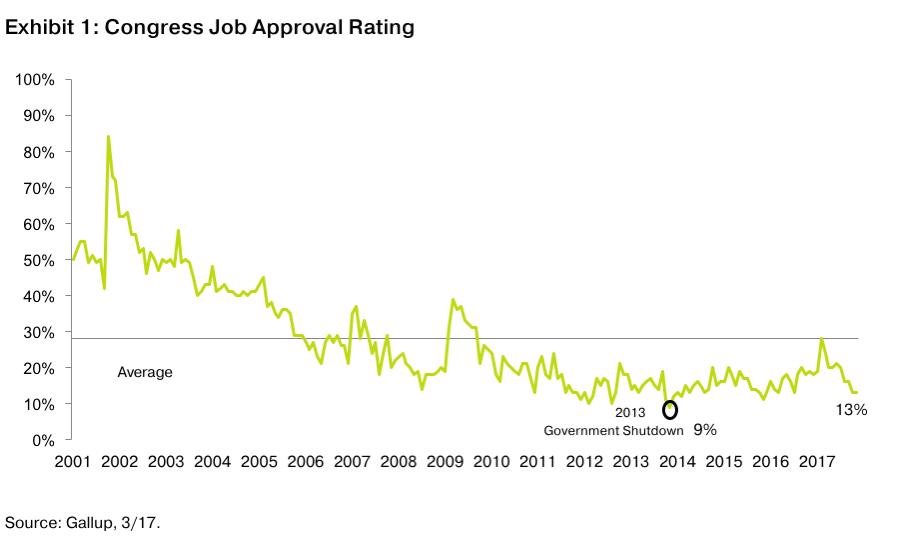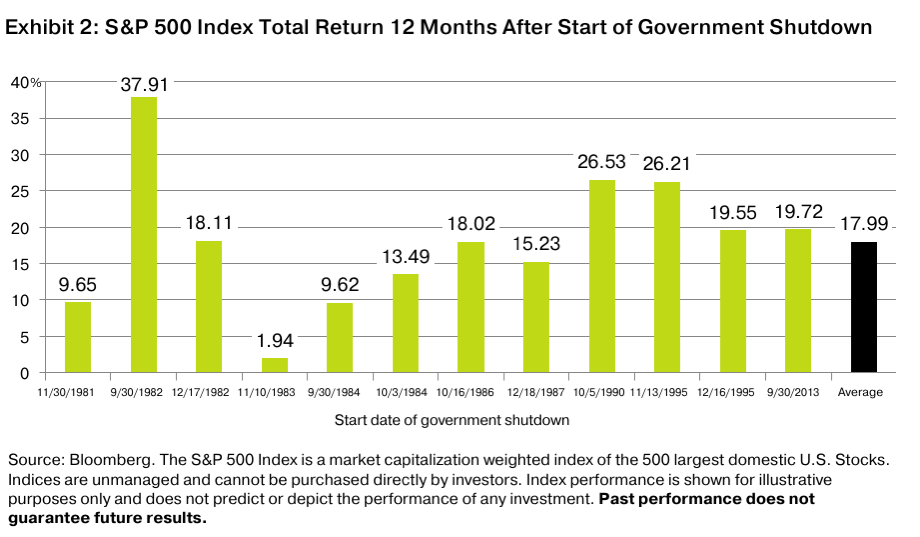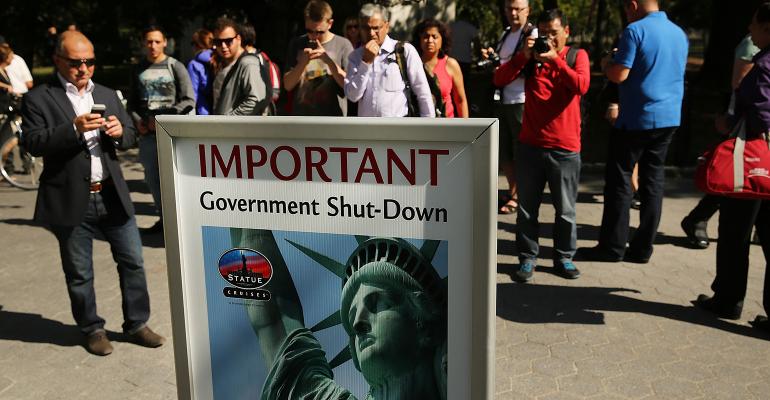By Brian Levitt
Here we go again.
The prospect of a federal government shutdown seems to arrive with the change of the seasons here in the Northeast. Think about it. We saw threats of a government shutdown in April, to coincide with the arrival of spring, before federal lawmakers passed a one-week stopgap spending measure to keep the government running. They eventually hammered out a funding bill that ran through the end of the fiscal year on September 30. Also in September, shortly before the fall equinox, disagreements over extending the U.S. debt ceiling and other budget priorities for the new fiscal year once again raised the prospect of a government shutdown before a deal was reached, to take us into December.
And now, here we are. With winter about to arrive, so has another threat of a government shutdown, which could come as soon as Friday.
On the basis of how well the 2013 government shutdown polled (72% of Americans opposed it), it’s fair to say the majority of the country does not want another congressional showdown. As John Adams once quipped, “I have come to a conclusion that one useless man is a shame, two is a law firm, and three or more is a congress.” Unfortunately, it’s not clear whether the public’s aversion to government shutdowns will be enough to prevent one from occurring.
Congress must pass legislation by Friday to appropriate money to fund government operations and agencies. Lawmakers may have some flexibility to keep the government open for two weeks beyond the deadline, although that may be easier said than done.
The funding bill requires 60 votes to pass in the Senate. However, promises made to secure passage of the tax bill have opened a deeper fissure between Democrats and Republicans on Capitol Hill. Deficit hawks want a sizable increase in military spending, while Democrats want non-defense spending to rise by the same amount as military spending. Failure to pass an appropriations bill will result in a government shutdown.
End Times Are Here, Right? Wrong.
Government shutdowns are not without precedent. The government has been shut down 13 times since modern congressional budgeting began in 1976, with shutdowns lasting an average 5.08 days.
- The longest shutdown lasted 21 days (Dec. 16, 1995 to Jan. 6, 1996) during President Bill Clinton’s first term.
- The most recent shutdown lasted 16 days (Oct. 1 to 16, 2013).
Even without a funding bill, essential government functions will continue to operate on Dec. 8 and beyond, with these functions, including, but not limited to, air-traffic control, border patrol, federal prisons, the power grid, mail delivery, disaster relief, food safety inspections, the military and tax collection. In addition:
- Seniors will continue to receive Social Security payments and Medicare coverage.
- Veteran benefits, unemployment benefits and food stamps will still be paid.
- All government workers will not be paid, but will receive their missed pay retroactively when Congress passes a bill to fund the government.
However, roughly 800,000 federal government employees who are deemed non-essential will be furloughed. An estimated 1.3 million workers who are considered “essential” will remain on the job and receive IOUs to be cashed in when the shutdown ends. As noted above, no federal employees will lose any money.
With non-essential workers off the job, non-essential government activities will cease. To name a few select examples:
- The Justice Department will suspend civil cases;
- NASA will furlough most of its employees but continue to provide support to the International Space Station;
- The National Institutes of Health will continue clinical trials but no new trials will be started;
- The National Zoos will be closed (the animals will be fed); and
- The National Parks will be closed. (Cue John Candy in National Lampoon’s Vacation: “Sorry folks, the park’s closed. The moose out front should have told ya.”)
If a government shutdown occurs, how long it may last is anyone’s guess. Government shutdowns typically end when one or both of the political parties can no longer withstand the public’s ire. In 2013, Congress’s approval rating during the government shutdown fell to a record-low 9 percent. To put it into context, head lice, root canals, and the band Nickleback all polled higher.
At the time, The Tonight Show host Jimmy Fallon quipped, “It’s gotten too bad ... now the approval ratings of Congress hit a record low of just 5 percent. There are a lot of pressing questions, namely, who’s in the 5 percent that still approves of Congress?” Today, Fallon would be looking for the 13 percent of Americans who still approve of Congress, down from a multi-year high of 28 percent in February. (Exhibit 1)

After more than two weeks of a government shutdown accompanied by withering public scorn, Congress approved a proposal to fund the government on Oct. 16, 2013, and President Obama signed it into law the next day. It is estimated the U.S. economy lost 0.6 percent of its 2013 projected annualized GDP growth, equal to $24 billion.
Government Shutdowns and the Markets
For investors, the good news is that government shutdowns historically have had limited impact on the stock market. In fact, in every instance, market returns have been positive in the 12 months following the beginning of the shutdown, including a 19.72 percent gain in the year after the 2013 shutdown. The broad market has posted an average return of 17.99 percent in the one-year period following the government’s 13 shutdowns! (Exhibit 2)

Whether we like it or not, a government shutdown may soon be upon us. Get ready for a bunch of jokes that sound like this one that Conan O’Brien delivered in 2013, “Our government may be shutting down in a few hours. So, folks, get ready for absolutely no noticeable difference.”
Still, the public noticed and demanded results. Let’s hope cooler heads prevail and the nation averts a shutdown. If it does occur, here’s hoping for a prompt resolution.
Brian Levitt is OppenhemierFunds' Senior Investment Strategist.




